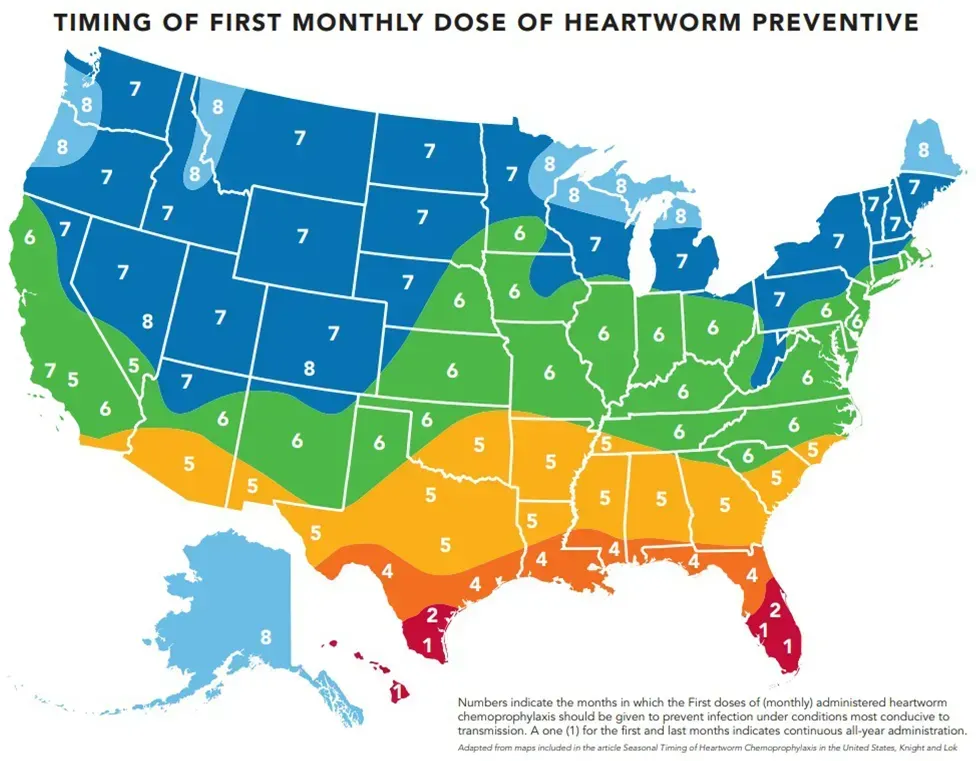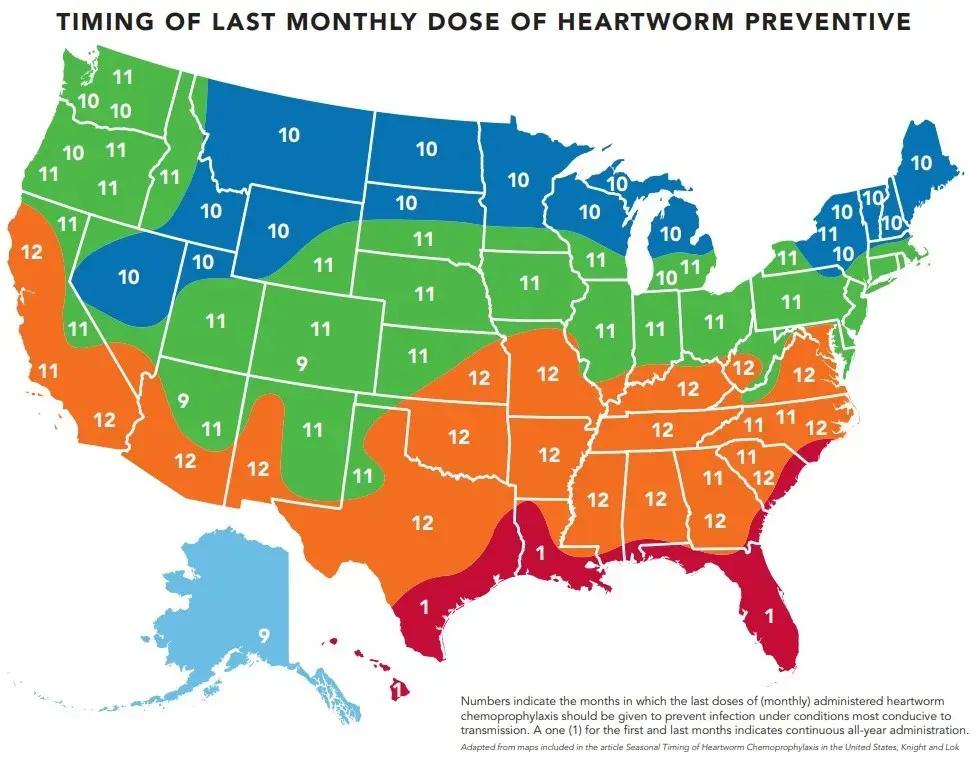Are You Helping Your Pet Stay Safe from Heartworms?
Year-round preventatives have been the norm for heartworm prevention, but are these chemical treatments really as effective as they seem? Here’s how to provide better protection for your companion animals.

STORY AT-A-GLANCE
- Heartworms, transmitted by mosquitoes, can infect pets and grow up to a foot long in their bodies. They can cause severe health issues, including heart problems and organ damage
- Symptoms of heartworm infection in dogs include lethargy, coughing and difficulty breathing. In cats, symptoms often relate to respiratory issues and can be more severe, potentially leading to sudden death
- Treatment for heartworm infection typically involves medication like Immiticide or a combination of ivermectin and doxycycline. Complete rest during treatment is crucial for optimal recovery
- Year-round heartworm preventatives may not be necessary in all regions. The need depends on local mosquito prevalence, with some areas only requiring three to seven months of prevention annually
- Natural prevention strategies include maintaining a strong immune system through proper diet, considering multimodal preventive protocols and avoiding overuse of chemical treatments that may lead to resistance
Spending time outdoors with your pet is a great way to bond, but it’s important to watch out for pests, such as mosquitoes. If you live in an area where populations of these pesky, blood-sucking parasites thrive, you must make sure to keep your pet safe from heartworms. According to the American Heartworm Society, more than 1 million pets in the United States now have heartworms.1
Basic Facts About Heartworms
In the U.S., more than 70 mosquito species are responsible for transmitting heartworms (Dirofilaria immitis) in pets. These pests serve as a host for microfilaria, which are young heartworms or larvae. When they mature and become infectious, usually within a couple of weeks, the heartworm can be transmitted to your pet when they are bitten by a mosquito.2
In your pet’s body, heartworms can circulate throughout the vascular system for seven months, then mature into adult heartworms. These parasites can grow up to a foot in length, and can survive in your dog’s body for around seven years. In cats, heartworms only live for a few years, and while they are more resistant to it than dogs, even a few worms can lead to serious infections.
Pets can have hundreds of heartworms living in their body,3 which can be fatal. If there’s a significant infestation, the worms will enter your pet’s heart and fill it eventually, causing blood clots. As a result, your pet’s heart will need to work abnormally hard to keep blood pumping through the arteries and circulating in their body. Heartworms also lead to severe inflammation in the arteries, which harms their lungs, liver and kidneys.
How Is Heartworm Infection Diagnosed?
Dogs and cats that are infected with heartworm may show several symptoms, however, they may not manifest when the infection is in its early stages. Usually, the symptoms depend on the infection load, the pet’s activity level and overall condition of your pet. Nevertheless, some of the most common indications of heartworm in dogs include:
- Lethargy or lack of energy
- Poor appetite
- A mild but consistent cough
- Unable to exercise/play/move around for long periods
- Difficulty breathing
- A swollen belly
In cats, symptoms of heartworm are usually brought on by an immune response and are related to the lungs, which is why it’s often called heartworm associated respiratory disease (HARD). Common indications include difficulty breathing, coughing and vomiting. In severe cases, additional symptoms include:
- Lethargy
- Weight loss
- Diarrhea
- Anorexia
- Blindness
- Fainting
- Rapid heart rate
- Convulsions
- Sudden death
If your dog or cat has been exposed to mosquitoes and is showing any of the symptoms listed above, it’s best to bring them to the vet immediately to be examined.
Heartworm Treatment Protocol
If your pet has unfortunately been diagnosed with heartworm infection, your vet may perform additional tests to confirm the severity of the disease. They will determine the overall prognosis, the ideal treatment approach and precautions for the best outcome.
After a heartworm diagnosis, your veterinary team will perform additional testing to determine the severity of your dog’s disease. Classification is used to help establish a patient’s overall prognosis, the most effective treatment approach, and what additional precautions may need to be taken.
Depending on your pet’s current situation, your vet may recommend using Immiticide to treat the infection. In some cases, a combination of ivermectin and doxycycline may be the best course of action. Some dogs may also be prescribed Benadryl or steroid therapy to mitigate the other side effects of the treatment.
One important reminder when treating a heartworm infection — your pet must remain inactive during the duration of the treatment, without any exercise. This means they must be confined to a crate or other small space. Complete rest is crucial to ensure optimal recovery.
Giving Heartworm Preventatives Should Depend on Where You Reside
So, what’s the best way to protect your pet against heartworm infections? While heartworm preventatives may seem like an ideal solution, remember that they are chemical treatments that may have dire long- and short-term consequences on your pet’s well-being. What’s more, heartworm "preventives" don't actually prevent the worms — rather, they poison the larvae, causing them to die inside your pet's body.
To make matters worse, there’s evidence that giving year-round heartworm preventatives is causing pets to develop resistance, which occurs due to the overuse of these drugs, rendering them ineffective.
In fact, there are only certain regions in the U.S. where a year-round heartworm preventative may be advisable. These areas include south Florida, south Texas, and a few other locations along the Gulf Coast. For the rest of the U.S., heartworm high exposure risk only ranges from three to seven months, with majority of states at six months or less. Consult the map below to determine when to start and stop using a heartworm preventive.


For example, if you live in an area where mosquitoes are a problem, such as on the Gulf Coast in either Texas or Florida, the map advises giving a preventive on the first day of January, and then giving it year-round. But if you live in areas where mosquitoes are not as widespread, such as in Washington or western Oregon, you can start dosing in July to August and then stop in October to November.
Other Heartworm Prevention Tips
Another common misconception that many pet parents fall for when it comes to heartworms is relying on natural deworming strategies that are used for gastrointestinal (GI) parasites, like diatomaceous earth. Unfortunately, these dewormers will be ineffective for heartworms, since these parasites don’t live in the GI tract — they live in the bloodstream.
If you live in an area where mosquitoes are widespread and there’s a significant chance your pet could be exposed to heartworm disease, follow these additional strategies to help protect against this illness:
- Keep your pet’s immune system strong and optimally functioning by feeding them a species-specific, nutritionally optimal, fresh food diet to help strengthen their natural defenses. Adding antiparasitic foods like fresh garlic in small quantities gives additional support.
- If you live in an area where there’s no high risk of acquiring heartworm, it’s best to consider a multimodal preventive protocol instead of relying solely on chemical treatments.
- Avoid “all-in-one” chemical treatments that claim to ward off external parasites and GI worms, as they increase your pet’s toxic load, which may add further burden on their body.











